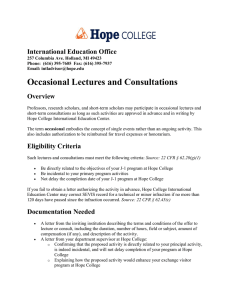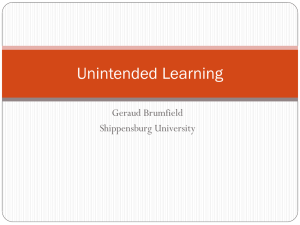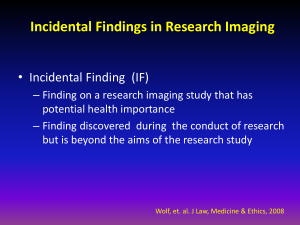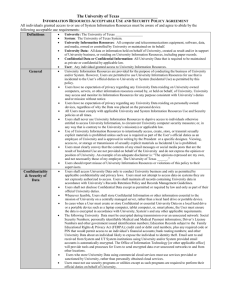IRB Primer: Incidental and Secondary Findings
advertisement
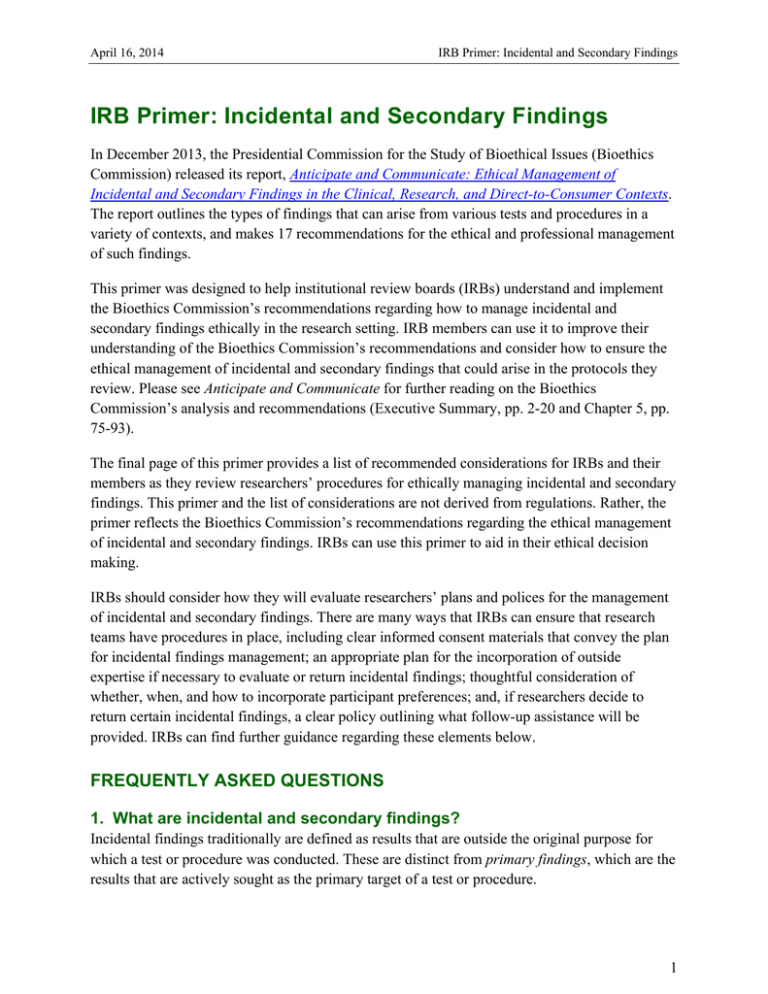
April 16, 2014 IRB Primer: Incidental and Secondary Findings IRB Primer: Incidental and Secondary Findings In December 2013, the Presidential Commission for the Study of Bioethical Issues (Bioethics Commission) released its report, Anticipate and Communicate: Ethical Management of Incidental and Secondary Findings in the Clinical, Research, and Direct-to-Consumer Contexts. The report outlines the types of findings that can arise from various tests and procedures in a variety of contexts, and makes 17 recommendations for the ethical and professional management of such findings. This primer was designed to help institutional review boards (IRBs) understand and implement the Bioethics Commission’s recommendations regarding how to manage incidental and secondary findings ethically in the research setting. IRB members can use it to improve their understanding of the Bioethics Commission’s recommendations and consider how to ensure the ethical management of incidental and secondary findings that could arise in the protocols they review. Please see Anticipate and Communicate for further reading on the Bioethics Commission’s analysis and recommendations (Executive Summary, pp. 2-20 and Chapter 5, pp. 75-93). The final page of this primer provides a list of recommended considerations for IRBs and their members as they review researchers’ procedures for ethically managing incidental and secondary findings. This primer and the list of considerations are not derived from regulations. Rather, the primer reflects the Bioethics Commission’s recommendations regarding the ethical management of incidental and secondary findings. IRBs can use this primer to aid in their ethical decision making. IRBs should consider how they will evaluate researchers’ plans and polices for the management of incidental and secondary findings. There are many ways that IRBs can ensure that research teams have procedures in place, including clear informed consent materials that convey the plan for incidental findings management; an appropriate plan for the incorporation of outside expertise if necessary to evaluate or return incidental findings; thoughtful consideration of whether, when, and how to incorporate participant preferences; and, if researchers decide to return certain incidental findings, a clear policy outlining what follow-up assistance will be provided. IRBs can find further guidance regarding these elements below. FREQUENTLY ASKED QUESTIONS 1. What are incidental and secondary findings? Incidental findings traditionally are defined as results that are outside the original purpose for which a test or procedure was conducted. These are distinct from primary findings, which are the results that are actively sought as the primary target of a test or procedure. 1 April 16, 2014 IRB Primer: Incidental and Secondary Findings Incidental findings can be either “anticipatable” or “unanticipatable.” An anticipatable incidental finding is one that is known to be associated with a test or procedure. Anticipatable incidental findings need not be common or even likely to occur—their defining characteristic is that the possibility of finding them is known. Unanticipatable incidental findings include findings that could not have been anticipated given the current state of scientific knowledge. Researchers cannot plan for these types of findings specifically. However, they can consider in advance what they might do if a particular kind of unexpected finding arises, for example, one that could be actionable or lifesaving. A secondary finding, by contrast, is not the primary target of the test or procedure; rather, it is an additional result actively sought by the practitioner. Secondary findings might be sought deliberately when doing so is recommended by an expert body or by a consensus of practitioners. The following table provides examples of each type of finding. Bioethics Commission Classification of Individualized Results of Medical Tests Source: Presidential Commission for the Study of Bioethical Issues (PCSBI). (2013, December). Anticipate and Communicate: Ethical Management of Incidental and Secondary Findings in the Clinical, Research, and Direct-toConsumer Contexts. Washington, DC: PCSBI, p. 27. Note: DTC = direct-to-consumer, ACMG = American College of Medical Genetics and Genomics. 2. What are some of the tests or procedures that could give rise to incidental and secondary findings? A variety of tests and procedures can give rise to incidental and secondary findings. Examples include: 2 April 16, 2014 IRB Primer: Incidental and Secondary Findings Large-Scale Genetic Sequencing: Genetic sequencing is the analysis and ordering of the billions of base pairs—the As, Ts, Cs, and Gs—that make up the human genome. Largescale genetic sequencing techniques include whole genome sequencing, whole exome sequencing, and other next-generation genomic analyses. Because of the large number of base pairs sequenced and potentially analyzed, large-scale genetic sequencing has the potential to yield large numbers of incidental and secondary findings. While some variants discovered during large-scale genetic sequencing reveal clinically relevant information, much of the data produced are of unknown or uncertain medical value. In addition, incidental and secondary findings that arise in genetic sequencing also can have implications for biologically-linked family members. Testing of Biological Specimens: Analysis of biological specimens such as blood, urine, or bodily tissues can be a source of incidental or secondary findings. Incidental and secondary findings arising from blood and tissue testing could definitively indicate a health issue of concern, or could require a series of additional diagnostic tests to determine the health implications, if any, of the result. For example, a researcher might order a metabolic panel to assess kidney function, but the laboratory results might reveal an incidental finding of liver dysfunction. Imaging: Medical imaging includes magnetic resonance imaging (MRI), computed tomography (CT) scans, X-rays, neuroimaging, and ultrasounds, among others. The images produced provide visualization of an entire field of study and can give rise to incidental and secondary findings in areas outside the area of diagnostic interest. For example, scans of the abdomen and pelvis can include images of the kidneys, liver, adrenal glands, and pancreas, only one of which might be the organ of interest to researchers. 3. Why should researchers inform research participants about the possibility of incidental and secondary findings? Researchers should communicate the fundamental aspects of their research—including the possibility of discovering incidental or secondary findings and the plan for their disclosure or management—so that participants can make fully informed decisions about whether to enroll. IRBs should review informed consent materials to ensure that researchers have included information about incidental and secondary findings and the plan for management of these findings. Researchers can ascertain at the outset what participants prefer to know—and not know—about incidental or secondary findings. For example, a participant might prefer to know about only those findings that are clinically significant, actionable, and lifesaving. Acting in accordance with participants’ expressed preferences about whether to receive incidental and secondary findings, to the extent possible, helps researchers to respect participants’ autonomy. If practical 3 April 16, 2014 IRB Primer: Incidental and Secondary Findings or logistical constraints prevent a researcher from searching for, interpreting, or disclosing incidental findings, the researcher can propose a plan that incidental and secondary findings will not be returned. Disclosing a plan for managing incidental findings, and allowing for nonparticipation if a prospective participant chooses, appropriately respects an individual’s ability to make autonomous and informed decisions about whether to participate in research. 4. What are some of the arguments in favor of returning—or not returning—incidental and/or secondary findings? Researchers and IRBs should carefully consider both the potential benefits and risks of disclosure of incidental and secondary findings. Disclosing certain incidental findings might lead participants to obtain lifesaving medical interventions, or help participants make informed medical decisions. However, disclosure also could lead to needless further testing, additional incidental findings, costs, and anxiety and distress, potentially with no corresponding medical benefit. Researchers should evaluate whether the prospective benefits of an action outweigh the risks. Researchers also should consider carefully whether to allocate time and resources to seeking secondary findings, or to interpreting, assessing, and disclosing incidental findings, especially when these decisions might benefit individuals in the research study but stall broader societal benefits of the research activity. Researchers do not have an ethical duty to seek secondary findings. However, researchers must determine how their incidental findings management policy will affect participants as individuals, and how it will affect their ability to create generalizable knowledge. The following table of ethical principles and their application to incidental and secondary findings can help researchers reconcile these considerations. 4 April 16, 2014 IRB Primer: Incidental and Secondary Findings Ethical Principles in the Research Context Principle Definition Application Respect for Persons This principle recognizes the fundamental human capacity for rational selfdetermination. Beneficence This principle calls on professionals to take action to ensure the wellbeing of others. Its corollary, non-maleficence, requires not imposing harm on others. Justice and Fairness This principle requires fair and equitable distribution of the potential benefits and burdens across society. Intellectual Freedom and Responsibility This principle protects sustained and dedicated creative intellectual exploration that furthers scientific progress, while requiring that researchers take responsibility for their actions. Researchers must communicate the fundamental aspects of their research—including the possibility of discovering incidental or secondary findings and the plan for their disclosure or management—so that participants can make informed decisions about whether to enroll. This principle supports returning findings when disclosure might help forestall or prevent harm. By contrast, disclosing an incidental finding for which no preventive or positive action can be taken has the potential to cause anxiety and distress with no corresponding medical benefit. The principle of justice and fairness calls upon researchers to take into account how policies for returning incidental and secondary findings could benefit or burden some participants or, alternatively, could burden the research enterprise and the ability to create generalizable knowledge. This principle supports affording wide latitude to researchers in pursuing their scientific goals and engaging in intellectual exploration for the good of society, while also expecting that researchers uphold and respect the trust placed in them by participants. Ethical conduct of research with human participants includes acknowledgment and planning for incidental and secondary findings. 5. What constitutes an ethically appropriate plan for the management of incidental and secondary findings? Researchers have an ethical duty to plan for incidental findings—whether common or rare—to the extent possible. However, researchers do not have an ethical duty to look for secondary findings. Researchers should develop a plan based on evidence about the analytic and clinical validity of potential findings and their clinical or reproductive significance, and careful consideration of the benefits, risks, and costs of disclosure, including the risk that seeking or analyzing incidental and secondary findings might distract from the central goal of research. For certain kinds of research, disclosure of incidental findings is difficult, if not impossible. For example, often, the data stored in biobanks are de-identified, and researchers cannot readily link the data to particular individuals, which makes the return of incidental findings infeasible or impractical. In such cases, researchers can develop a plan of nondisclosure, which should be thoughtfully deliberated and evaluated by an IRB. IRBs should review researchers’ plans for managing incidental findings, and ensure that all relevant issues are considered thoughtfully. IRBs can consider the following elements in determining what guidance to offer investigators. 5 April 16, 2014 IRB Primer: Incidental and Secondary Findings Informed Consent Researchers should develop a plan for managing the types of findings that might arise, and clearly communicate the plan to participants during the informed consent process—even if the plan is not to disclose any incidental or secondary findings. This allows individuals to choose not to participate in research if they are uncomfortable with a researcher’s management plan. When reviewing consent materials, IRBs should evaluate whether the following elements have been considered and included. Secondary findings that will be actively sought and returned to participants should be conveyed in the informed consent process, and there should be a specific plan for their return. A plan for anticipatable incidental findings (e.g., that researchers will or will not return some or all potential findings) also should be conveyed in the informed consent process, and, to the extent that the findings will be returned, a plan should be described. For findings that are unanticipatable, researchers should plan for the types of findings that might arise and plan for return if applicable (e.g., that researchers will return unanticipatable lifesaving findings, but will not return unanticipatable findings of unknown significance). Expertise Some incidental findings could fall outside of researchers’ expertise. IRBs should verify that researchers are sufficiently familiar with anticipatable incidental findings associated with the tests or procedures used in their research to formulate and communicate a plan for how these findings will be managed. If researchers need additional expertise to manage incidental and secondary findings, an IRB could suggest they add this expertise by, for example: adding members to the research team who have sufficient expertise to manage the range of anticipatable incidental findings; relying on research ethics consultants or IRBs if there is uncertainty as to the advisability of disclosing a particular finding to a participant; and/or seeking qualified clinical or diagnostic experts for consultation when researchers are uncertain whether a finding has clinical or reproductive significance. IRBs should consider whether they have the resources or expertise to assist researchers when considering difficult cases. In addition, IRBs should provide guidance to inform how researchers might develop and communicate the plan for disclosing and managing findings that are outside the researchers’ area of expertise. For example, researchers might wish to disclose genetic 6 April 16, 2014 IRB Primer: Incidental and Secondary Findings incidental findings in the presence of a genetic counselor to assist participants in understanding the finding’s significance. Participant Preferences If researchers plan to inform participants of certain types of incidental or secondary findings, they should decide in advance how to respect the wishes of participants who choose to opt out of receiving these findings. IRBs should review researchers’ plan for communicating findings, which should be communicated as part of the informed consent process. If researchers have ethical objections to allowing participants to opt out of receiving clinically significant, actionable, and lifesaving findings, they need not enroll such individuals in their research study. Delineating such exclusion criteria for study enrollment will minimize this type of ethically challenging situation once the research protocol is underway. If researchers do not object to allowing participants to opt out of receiving incidental findings—and participants are well informed regarding what opting out could mean for their health and wellbeing—researchers may enroll such participants in the research. If a researcher discovers a potentially lifesaving unanticipatable incidental finding for a participant who has opted out of receiving incidental findings generally, the investigator should seek advice from an IRB about whether and how to disclose it. IRBs should be prepared to answer researchers’ questions about whether to disclose a lifesaving incidental finding to a participant who has opted out. Researcher Responsibilities Researchers’ plans for managing incidental findings also should include a description of the research team’s responsibilities following disclosure of such a finding. In some cases, researchers might provide: basic educational information about the nature of the finding; advice regarding how to seek care from a clinician or specialist; guidance about obtaining health insurance to secure treatment; and/or a referral to a clinical specialist, if one is required. 7 April 16, 2014 IRB Primer: Incidental and Secondary Findings Considerations for Ethical Management of Incidental and Secondary Findings Identifying Incidental and Secondary Findings: □ Researchers should identify any secondary findings they plan to seek actively during their research. □ Researchers should identify any anticipatable incidental findings that might arise during their research. □ Researchers should identify the general types of unanticipatable incidental findings that might arise during their research (e.g., lifesaving, clinically actionable, of unknown significance). Recognizing and Analyzing Incidental and Secondary Findings: □ Researchers should have a plan for recognizing, analyzing, and handling incidental and secondary findings. □ If anticipatable incidental or secondary findings might require additional expertise to recognize or analyze, researchers should consider adding such expertise to the team (e.g., consulting a professional with the necessary expertise or otherwise having one available for consultation). Informed Consent for Incidental and Secondary Findings: □ Researchers should inform potential participants of the following: □ Secondary findings they intend to seek and return. □ Anticipatable incidental findings that might arise during the research and the plan for returning results. □ General types of unanticipatable incidental findings that might arise during the research and the plan for management of such findings. □ Researchers should describe the kinds of findings that might be disclosed, the process for disclosing them, and whether and how participants might opt out of receiving certain findings. □ Researchers should indicate in the informed consent process any exclusion criteria for individuals who wish to opt out of receiving clinically significant, actionable, and lifesaving findings. Returning Incidental and Secondary Findings: □ Researchers should have a designated plan for returning incidental and secondary findings to participants. The plan might include the option for participants to opt out of receiving incidental or secondary findings, or might be to return no findings to participants. □ Researchers should respect the wishes of participants who choose to opt out of receiving incidental or secondary findings, but in the event a researcher discovers a potentially lifesaving unanticipatable incidental finding for a participant who has opted out of receiving incidental findings, the investigator should seek advice from an IRB about whether and how to disclose it. 8
